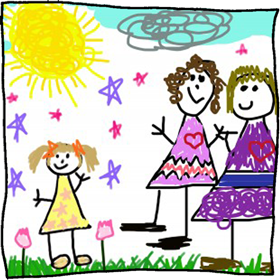Every child is an artist.
Their early drawings all have a bright yellow sun above smiling stick-like figures standing among loopy red flowers on a green line—the edge of the earth. There might even be a few dabs of blue for the sky. Shades of crayon brilliance.
Are children born knowing that the sun is a yellow circle with rays in the upper corner of your drawing paper?
And, if you’re like Picasso’s parents, you save every drawing your child makes. Not just for the refrigerator door, but for posterity.
We love to see our children’s creations and we dutifully praise their work. When your child draws a picture of Mommy, we express delight, even though the drawing looks like a pineapple eating an antelope of some kind.
Yes, we all agree with Picasso’s parents: my child may be a genius in the making, too.
Picasso was a child prodigy. As a boy, he drew like Raphael, he said, and that it took him a lifetime to learn to draw like a child. Sadly, he never learned to put a bright yellow sun in the corner. (Guernica has a sun in the sky or is it an eyeball with a lamp in it?) Maybe Picasso never found what he called the “genius of childhood.”
So, congratulations, your 9-year old is already ahead of Picasso.
But, sadly, by age 18, most American children are no longer artists. They no longer draw the indecipherable scribbles that showed such promise. They no longer even seem creative.
They become sullen, indecipherable teenagers. Every ounce of creative juice drained from their souls as if the Army Corps of Engineers were running the schools.
We all believe that this is true, that American schools despise imagination and drum it out of every child so that it’s gone by high school graduation. We believe that our children enter Kindergarten with active, fruitful imaginations and graduate 13 years later with imaginations as sharp as a banana.
But, where is the evidence that proves this myth? We’ve all read and hear enough anecdotes to make it seem believable. You can walk into a classroom of 2nd or 3rd graders and you can feel them bubbling with ideas and imagination. And, many adults can tell you how their creative dreams were squelched, ignored and denied in school.
Certainly, American schools can do much more to foster creativity by supporting individual imagination. (H-IQ is also a tool to increase the importance of creative work in the schools.) But, the equation of imagination in and silence out in 13 years may have more to do with maturation rather than schools.
In the early grades, children learn how the world fits together and they are eager to talk about it. When they bump into the gaps in their knowledge of the world, they improvise or guess, searching for the associations that make the world comprehensible. For example, when I taught songwriting in grade schools, I would open my guitar case and, without prompting, children would announce, uninvited, their associations with my guitar:
Child #1: “My uncle has a guitar.”
Child #2: “We have a dog.”
Child #3: “We went downtown last night.”
At first glance, there is no connection between these three statements. Except…I’m a guest with a guitar that is important to me. Child #1’s association is clear: he’s no stranger to guitars. Child #2 has a dog, not quite a guitar, but something that is important to her. And speaking of what’s important, Child #3 wants us to know that going downtown with her family was as important as any dog or guitar. So, there.
In a few years, these children will learn that dogs, guitars and downtown excursions are not associations older people normally make. But, at that young age, you try everything to imagine the world beyond your ken. This unpredictability strikes adults as imaginative or “creative.”
So, as children reel off associations like blindfolded bingo callers, we see their imaginations at work, predicting how the world fits together.
Fast forward to high school. Now, these same children wouldn’t be caught dead associating a pet with a musical instrument. However, their imaginations are still active. But, now they are asking not how the world fits together, but rather how do I fit into the world? They have moved from external questions to internal questions. The uncertainty of fitting in keeps these questions inside or shared with trusted friends. The bingo calling of associations has given way to unspoken reflection.
The children who once channeled their imaginations outward, now turn their imaginations inward.
High school students may not be openly involved in creative work (though many are) that doesn’t mean that their imaginations have evaporated.
Ask any principal about high school pranks. They will tell that student imagination overflows—into the wrong places.
Imagination doesn’t go away in the inexorable march to adulthood. It gets re-channeled from predicting the world to predicting the self.
I hope your parents kept all your art work. They are sitting on a gold mine. Especially, if the yellow sun is floating in an upper corner. It’s tangible proof that you have a productive imagination.





